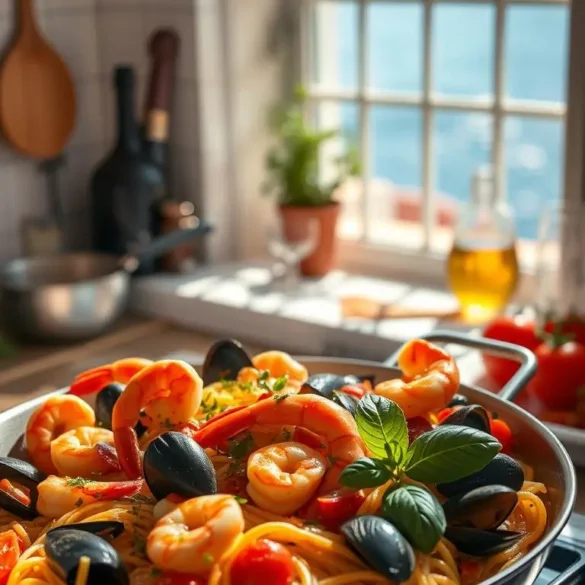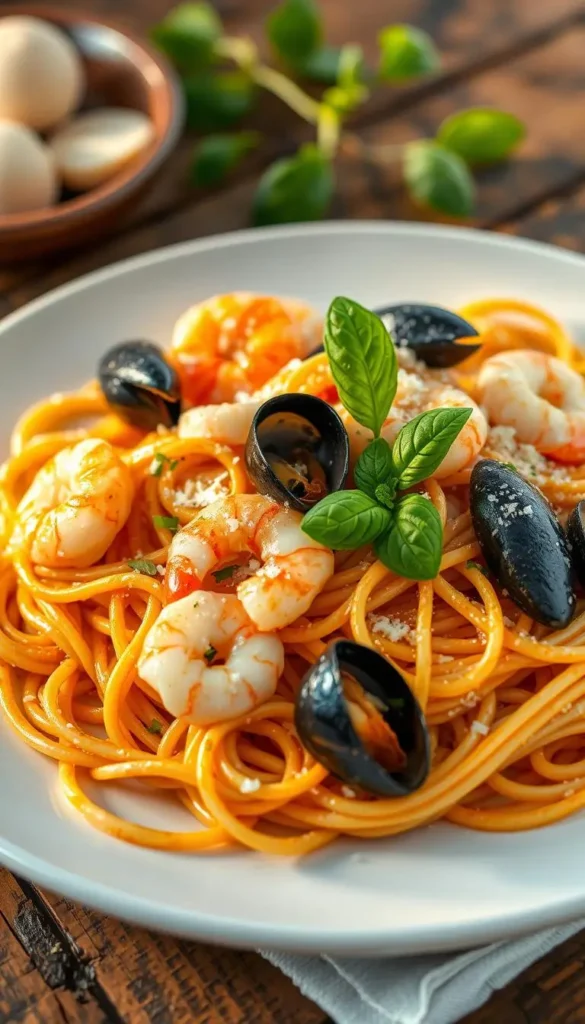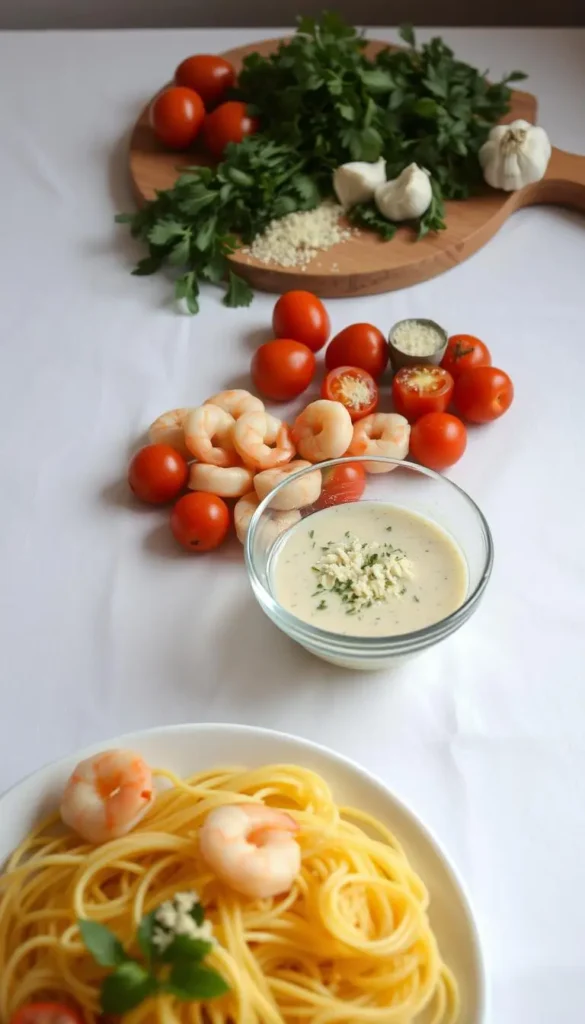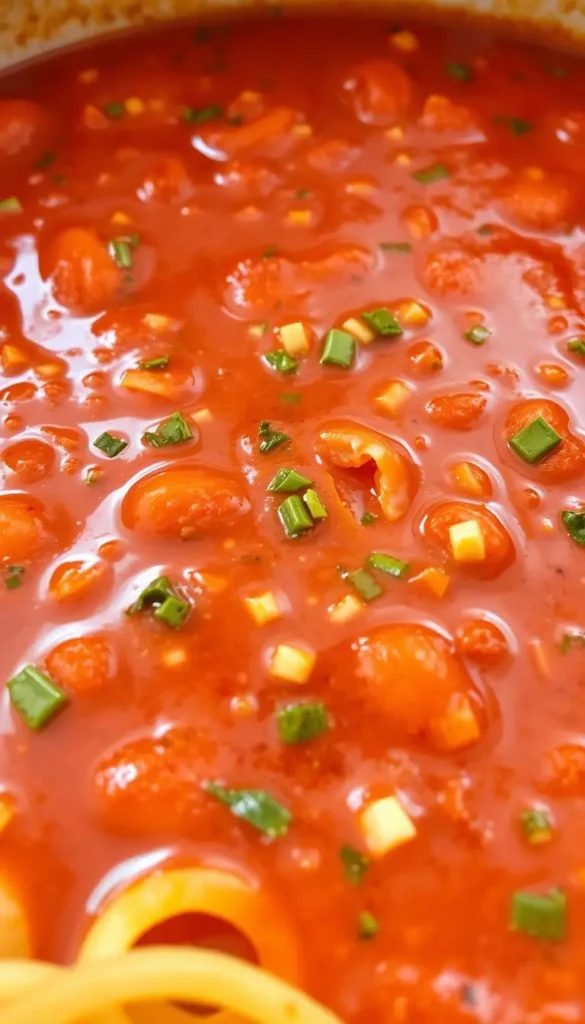
Ingredients
- 8 oz pasta (spaghetti or linguine)
- 1 lb mixed seafood (shrimp, mussels, and squid)
- 2 tablespoons olive oil
- 4 cloves garlic, minced
- 1/2 cup white wine
- 1 cup heavy cream
- 1/4 cup grated Parmesan cheese
- 1 tablespoon fresh parsley, chopped
- Salt and pepper to taste
- 1 teaspoon red pepper flakes (optional)
Instructions
1. Cook the pasta according to the package directions. Drain and set aside, reserving a little pasta water. 2. Heat olive oil in a large skillet over medium heat. Add garlic and sauté for 1-2 minutes until fragrant. 3. Add the mixed seafood to the skillet and cook for 5-7 minutes, until the seafood is cooked through. 4. Pour in white wine and let it simmer for 2-3 minutes to reduce slightly. 5. Stir in the heavy cream and bring to a simmer. Allow the sauce to thicken for about 5 minutes. 6. Add the cooked pasta to the skillet and toss to combine with the seafood and sauce. If needed, add a little pasta water to adjust the sauce consistency. 7. Stir in Parmesan cheese, and season with salt, pepper, and red pepper flakes to taste. 8. Garnish with fresh parsley and serve immediately.
Notes
For a lighter version, use half-and-half instead of heavy cream. You can also add a squeeze of lemon juice for a tangy finish. This recipe pairs wonderfully with a crisp white wine or a fresh green salad.
Table of Contents
Summer is the perfect time to enjoy fresh, flavorful meals that bring the taste of the ocean to your table. With the right techniques, you can create restaurant-quality dishes right in your kitchen. This article will guide you through a variety of recipes designed to impress your family and friends.
Thank you for reading this post, don't forget to subscribe!
Timing is crucial when cooking seafood. Overcooking can lead to a chewy texture, so pay attention to the minutes on the clock. Using the right heat and combining fresh ingredients with pasta water ensures a perfectly balanced dish. Whether you’re using shrimp or other seafood, these tips will elevate your cooking game.
From mastering the art of seasoning to creating rich sauces, you’ll learn how to make every bite memorable. Let’s dive into these recipes and discover how easy it is to prepare a meal that feels like a gourmet experience.
Key Takeaways
- Create restaurant-quality meals at home with simple techniques.
- Timing is key to avoid overcooking seafood.
- Use fresh ingredients and pasta water for a balanced dish.
- Master seasoning and sauces to enhance flavor.
- Summer is the ideal time to enjoy these recipes.
Ingredients and Preparation for a Perfect Seafood Pasta
Crafting a memorable meal starts with the right ingredients and careful preparation. The quality of your dish depends on how well you select and prep each component. Let’s break down the steps to ensure your meal is a success.

Selecting and Cleaning Fresh Seafood
Choosing the freshest ingredients is crucial. Look for shrimp, squid, scallops, or clams that are firm and have a clean, ocean-like smell. Avoid any with a strong fishy odor or slimy texture.
Once you’ve selected your seafood, cleaning is the next step. Rinse clams thoroughly to remove sand. Pat shrimp and scallops dry with a paper towel to ensure they cook evenly. Proper cleaning enhances both flavor and texture.
Prepping the Pasta and Essential Ingredients
Start by boiling your spaghetti or linguine according to package instructions. Reserve a cup of pasta water before draining. This starchy liquid helps bind the sauce and ingredients together.
Fresh garlic and parsley are key to building flavor. Mince the garlic finely and chop the parsley for even distribution. These ingredients add depth and brightness to your dish.
Measure your ingredients carefully. A pinch of salt can elevate the flavors, while too much can overpower the dish. Balance is essential for a harmonious meal.
- Select firm, fresh seafood and clean it thoroughly.
- Cook spaghetti or linguine, reserving a cup of pasta water.
- Use fresh garlic and parsley for enhanced flavor.
- Measure ingredients like salt precisely for balanced taste.
By following these steps, you’ll set the stage for a dish that’s both flavorful and perfectly textured. Preparation is the key to success.
Cooking Seafood Pasta: Techniques and Timing
Mastering the art of cooking seafood dishes requires precision and attention to detail. Each type of seafood, from scallops to shrimp, has its own ideal cooking time. Overcooking can lead to a tough texture, while undercooking may leave it raw. Timing is everything.
Managing Different Seafood Cooking Times
Scallops, for example, cook quickly—just 1-2 minutes per side on medium-high heat. Shrimp takes slightly longer, turning pink and opaque in about 3-4 minutes. Squid requires even more care, as it can become rubbery if overcooked. Cook it for 30 seconds to 1 minute for tender results.
To avoid uneven cooking, consider preparing each ingredient separately. This ensures that every component is perfectly cooked before combining them into the final dish.
Using Pasta Water and Heat for the Ideal Texture
Pasta water is a secret weapon in creating a silky, cohesive sauce. Its starchy consistency helps bind the ingredients together. Add it gradually to your pan, stirring as you go, to achieve the perfect texture.
Heat control is equally important. Use medium heat to gently simmer the sauce, allowing the flavors to meld without burning. A drizzle of olive oil and a pinch of pepper can enhance the natural taste of the seafood.
For a richer flavor, consider adding a hint of tomato puree. This adds depth and a touch of sweetness to the dish, balancing the savory notes.
Creating a Flavorful Sauce for Your Dish
A rich, flavorful sauce can transform any dish into a culinary masterpiece. The right combination of ingredients and techniques ensures a balanced, aromatic result that complements your meal perfectly.

Enhancing the Sauce with White Wine and Garlic
Start by heating a tablespoon of olive oil in a deep pan. Add a tablespoon of butter and let it melt. Next, toss in finely minced garlic, cooking it over low-medium heat for about a cook minute. This step releases the garlic’s aroma without burning it.
Infusing Fresh Herbs and Spices
Add a teaspoon of chopped parsley and a pinch of red pepper flakes for a hint of spice. Stir in a tablespoon of olive oil to enrich the sauce’s texture. If you’re using mussels, toss them in now, letting their juices blend into the mixture.
Simmer the sauce gently, adjusting the heat to avoid boiling. Taste and adjust seasoning with a pinch of salt or a dash of pepper. The result is a robust, well-rounded sauce that’s perfect for your dish.
Customizing Your Seafood Pasta Experience
Personalizing your meal allows you to explore new flavors and adapt recipes to your preferences. Whether you’re working with what’s available or experimenting with new ideas, small changes can make a big difference. Let’s dive into how you can tailor your dish to suit your taste.
Swapping Seafood Options
One of the easiest ways to customize your dish is by swapping seafood types. If shrimp isn’t your favorite, try mussels or fish. Lobster can add a luxurious touch, while clams bring a briny depth. Each option offers a unique flavor profile, so choose based on availability and preference.
When substituting, note the cooking times. Mussels cook quickly, while fish fillets may take a bit longer. Adjust your timing in the pot to ensure everything is perfectly done.
Adjusting Ingredients for Flavor
Ingredient ratios can also be tweaked to suit your taste. For a richer sauce, increase the amount of butter. A splash of dry white wine can enhance the aroma and add complexity. Fresh herbs like parsley or basil can brighten the dish, while red pepper flakes introduce a hint of spice.
Here’s a quick guide to ingredient adjustments:
| Ingredient | Adjustment | Effect |
|---|---|---|
| Butter | Increase by 1 tbsp | Richer, creamier sauce |
| Dry White Wine | Add ½ cup | Enhanced aroma and depth |
| Red Pepper Flakes | Add ¼ tsp | Mild heat and spice |
Experimenting with Noodles
If you’re tired of traditional spaghetti, try different noodle types. Linguine works well with thicker sauces, while angel hair pairs nicely with lighter preparations. For a gluten-free option, rice noodles or zucchini spirals are excellent alternatives.
Follow the instruction on the package for cooking times. Reserve some cooking water to help bind the sauce and ingredients together.
Balancing Your Dish
When making adjustments, ensure the dish remains balanced. Too much butter can overpower the seafood, while too little seasoning may leave it bland. Taste as you go and make note of any changes for future reference.
With these tips, you can create a meal that’s uniquely yours. Enjoy the process and let your creativity shine!
Conclusion
Bringing restaurant-quality flavors to your kitchen is easier than you think. Start by selecting fresh ingredients like shrimp scallop and using dry white wine to enhance the sauce. Proper preparation and medium heat ensure every bite is perfectly cooked.
Remember to check that all clams or mussels open after cooking for safety. Timing is key—measured in cook minutes—to avoid overcooking. Experiment with variations to suit your taste, whether it’s adding a clove of garlic or a pinch of sugar for balance.
With these steps, you can create a dish that’s both delicious and impressive. Follow the package instructions for your noodles, and don’t forget to add pasta water for a silky sauce. Enjoy the process and savor the results!
FAQ
What’s the best way to clean fresh shrimp and scallops?
Rinse them under cold water and remove shells or veins. Pat them dry with a paper towel before cooking.
How do I prevent overcooking seafood in my dish?
Cook shrimp and scallops for 2-3 minutes per side on medium heat. Add them toward the end to maintain tenderness.
Why is pasta water important for the sauce?
The starchy water helps bind the sauce to the noodles, creating a creamy, cohesive texture.
Can I use frozen seafood instead of fresh?
Yes, but thaw it completely and pat it dry to avoid excess moisture in the dish.
What’s the best type of wine for the sauce?
A dry white wine like Sauvignon Blanc or Pinot Grigio enhances the flavor without overpowering it.
How can I add more depth to the sauce?
Sauté garlic in olive oil, deglaze with wine, and finish with fresh parsley or a pinch of red pepper flakes.
Can I substitute spaghetti with another type of noodle?
Absolutely! Linguine, fettuccine, or even angel hair work well with seafood-based sauces.
What’s the ideal cooking time for al dente pasta?
Follow the package instructions but check 1-2 minutes before the suggested time for the perfect texture.
How do I store leftovers?
Keep them in an airtight container in the fridge for up to 2 days. Reheat gently to avoid overcooking the seafood.
Can I add other ingredients like mussels or clams?
Yes, mussels and clams add a rich flavor. Steam them in the sauce until they open, discarding any that remain closed.


